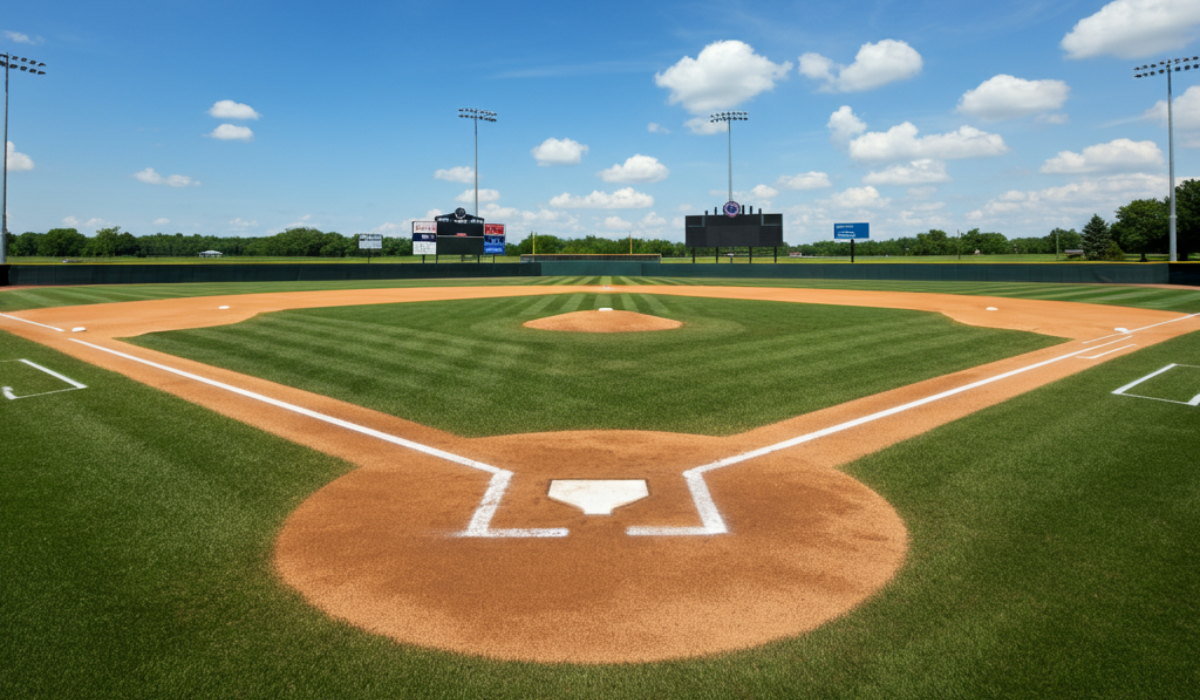Have you ever wondered why a baseball field is called a “diamond”? It’s not because it glitters in the sun (though, sometimes, it does)—it’s because the layout of the infield forms an actual diamond shape. But there’s so much more to a baseball field than meets the eye. Each part of the diamond is carefully designed to maximize play, strategy, and yes, thrill.
The 2019 NFHS Baseball Rules Diagram also provides detailed measurements and layouts for laying out a baseball field.
Whether you’re new to the sport or a longtime fan looking to brush up on your knowledge, this guide will break down every piece of the baseball diamond, from the pitcher’s mound to the on-deck circle, so you can wow everyone during your next game day outing or trivia night.
The Anatomy of a Baseball Diamond
At first glance, a baseball field looks like a giant puzzle. But each piece of the diamond—and the surrounding field—plays an essential role in the game. Here’s how it’s all laid out.
The Infield
Ah, the infield—the beating heart of baseball. This is the area bounded by the four iconic bases (more on those later). While the bases make up the diamond itself, this square-shaped dirt field (each side measures 90 feet in professional baseball) is where much of the action happens. From ground balls to batting strategies, the infield is where magic—and chaos—unfolds.
And I don’t know about you, but nothing screams “baseball” more than the sight of perfectly raked dirt and those crisp white bases. It’s almost too pretty to mess up…almost.
Key Features of the Infield:
- Home Plate: The starting and ending point of it all. This is where the batter stands, armed with their bat, ready to face an incoming 90 mph pitch.
- First Base: The first stop for runners who’ve made contact with the ball. Step on this bad boy and you’re safe (sometimes after a really close call).
- Second Base: Right smack in the middle of the diamond. Often a crucial target for double plays.
- Third Base: Runners hold their breath as they round third, knowing home plate—and a potential score—is just a sprint away.
The Outfield
Past the dirt and bases lies the outfield, the grassy expanse most baseball fans have lounged on at some point during amateur games. The outfield stretches from the infield all the way to the outfield fence—and here’s where those spectacular catches and deep fly balls steal the show.
Outfielders play an incredible role (shoutout to all the center fielders out there). Their job? Chase down balls, throw missiles to infielders, and prevent runs that could change the game in seconds.
Pro Tip
If you’re lucky enough to catch a long ball in the outfield during a professional game, don’t forget the “golden rule”: throw it back if it’s the opposing team’s homer. Fans hold you to it. Seriously.
The Pitcher’s Mound
Fun fact—did you know that the pitcher’s mound is slightly raised? It’s about 10 inches higher than the rest of the field, giving pitchers a strategic advantage. From here, pitchers showcase their skills with fastballs, curveballs, and all the funky pitches in between.
This sacred ground sits exactly 60 feet 6 inches from home plate. Why the oddly specific measurement? Because it creates the perfect balance between hitters and pitchers. Too close, and batters might never stand a chance. Too far, and the advantage leans toward the batter.
The Foul Lines and Fair Territory
Ever noticed the two lines extending diagonally from home plate? These are the foul lines. They stretch from home plate past first and third bases all the way to the outfield fence.
Basically, these lines separate fair territory from foul territory. Hit the ball within the lines? Play on! Hit it outside the lines? Foul ball, try again.
Batter’s Box and Catcher’s Box
Right next to home plate are the batter’s box and catcher’s box.
- The Batter’s Box is where hitters station themselves to take a swing. It’s their little patch of turf to dig into and focus.
- The Catcher’s Box sits just behind home plate. The catcher crouches here, ready to receive pitches while signaling to the pitcher for their next move.
Some say that what happens between the pitcher, batter, and catcher is an art form. I’d argue that’s entirely true.
The On-Deck Circles
On either side of the field, you’ll spot small circles painted near the dugout. These are the on-deck circles, where the next batter gets ready for their turn. Think of this as the warm-up area—a chance to loosen up, adjust batting gloves, and mentally prepare to (hopefully) smash a homer.
Coach’s Boxes
Last but not least, we have the coach’s boxes, located near first and third bases. These areas are where base coaches can stand to guide runners, shout instructions, or frantically wave their arms to stay! (Honestly, they look like they’re conducting an orchestra half the time, don’t they?)
Fun Facts about Baseball Diamonds
- Many Major League Baseball fields, like Fenway Park, have unique field dimensions due to space constraints. That “Green Monster” left-field wall isn’t just for show!
- A carefully prepared pitcher’s mound includes clay, and groundskeepers use laser leveling to ensure precision.
- Baseball diamonds follow strict guidelines from the 2019 NFHS Baseball Rules Diagram, which details every measurement for league games.
FAQs About the Baseball Diamond
Why is it called a “diamond”?
Because when you connect the four bases with lines, it forms a diamond shape. Simple as that!
How big is the outfield?
Outfield sizes can vary depending on the stadium. Generally, the distance from home plate to the outfield fence ranges from 300 to 450 feet.
Why are the bases 90 feet apart?
This distance was chosen because it creates an exciting balance. It allows runners enough time to beat out a ground ball but still gives fielders a chance to make a play.
What’s the purpose of raising the pitcher’s mound?
Raising the pitcher’s mound provides leverage and allows pitchers to throw with greater velocity and accuracy toward the batter.
Take It to the Diamond
Every single part of the baseball diamond is meticulously crafted and thought out, from its iconic layout to the little details that give it character. The next time you’re at a game, take a moment to appreciate its design—and maybe even drop some of these facts. You’ll impress your friends and add a new layer of excitement to America’s favorite pastime.
Now, grab your cap and mitt. It’s time for your next ballgame adventure!

